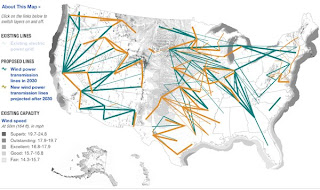Only a dream?
 The debate continues over just what needs to be done to bring the U.S. electric grid into the 21st century. Most experts agree that we need a "smarter grid". The debate focuses on whether or not a transcontinental grid system should be developed.
The debate continues over just what needs to be done to bring the U.S. electric grid into the 21st century. Most experts agree that we need a "smarter grid". The debate focuses on whether or not a transcontinental grid system should be developed.I've posted stories on this before. Here's yet another take on the subject. (GW)
Energy experts generally agree that the electrical grid in the United States needs to be upgraded if the country is to increase its use of renewable-energy sources like wind power and significantly reduce emissions of greenhouse gases. But plans to string new high-voltage lines to bring wind power from the midsection of the country to the coasts, where most of the demand is, could be expensive and unnecessary, and a distraction from more urgent needs, some experts say.
A new national grid, which has been likened to the Interstate Highway System constructed in the 1950s, has been proposed by groups such as the Center for American Progress, a Washington-based think tank, and AEP, a large utility; elements of the plans have been included in recent federal legislation. According to this vision, new high-voltage transmission lines costing billions of dollars would be built across the country, augmenting the existing patchwork of transmission lines much as the Interstate Highway System laid down high-speed roadways over an existing network of highways. But such a plan is "only a dream," says Paul Joskow, president of the Sloan Foundation and a professor of economics at MIT. "It's expensive. It's politically contentious. In the end, I think you're better off spending the money on other things."
What's needed instead are improved local and regional electricity transmission, the development of an efficient and adaptable smart grid, and the demonstration of technology such as carbon capture and sequestration, which could prove a cheaper way to reduce carbon dioxide emissions than transmitting power from North Dakota to New York City.
To be sure, new local and regional transmission lines are needed to bring wind power to market, since many wind farms are located in remote areas without the necessary connections to the grid. Indeed, last week, investor T. Boone Pickens said that he's halting his planned four-gigawatt wind farm in Texas in part because of a lack of transmission lines to carry the power from the farm to urban centers. And Steven Specker, the president and CEO of the Electric Power Research Institute, says that the lack of such transmission is the biggest obstacle to the growth of renewables.
But national transmission lines are a different story: they would face large obstacles and may not be necessary. Unlike local and regional transmission projects, where regulatory mechanisms are in place to distribute the costs of construction, it's not clear who would pay for a national grid. There could also be resistance from states between the wind farms and the coasts, which would have to give up land for the transmission lines without benefitting from the power that they carry. What's more, some politicians have moved to block such lines because wind power from North Dakota could threaten local wind power companies in places such as New England.
A national system would also be expensive. A study by the utility AEP suggests that a new national system of 19,000 miles of high-voltage lines would cost $60 billion. It's unclear whether the costs of such a system will be competitive with other approaches to reducing emissions, says Steven Hauser, vice president of grid integration at the National Renewable Energy Laboratory, in Golden, CO. "It may be cost effective to build it from North Dakota to Chicago; building it to Boston or to Los Angeles may not," he says. "From a cost point of view, where's the point of no return?"
What's more, advances in technology could change the economics involved and make long-distance wind transmission projects obsolete. For example, far-offshore wind farms could be located just a few dozen miles from major cities and provide wind power that is cheaper and more reliable than wind farms on land.
Hauser says that ultimately, stringing high-voltage trunk lines from the Midwest to the rest of the country is unnecessary. What's more important is developing a smarter grid. Equipping transmission lines, distribution networks, and electrical appliances in homes and businesses with sensors and controls that can communicate remotely with grid operators could reduce demand for electricity, allow existing lines to handle more electricity, and make it easier to integrate wind and other intermittent renewable-energy technologies.
As it is, grid operators have little information about real-time conditions on the grid and no control over demand. With a smart grid, power could quickly be rerouted in response to increases and decreases in wind power. Operators would know how hot transmission lines are getting, allowing them to decide with more accuracy how much power they can carry. Also, consumers could program their homes to use less power during times of peak demand, reducing the need for new power plants.
Copyright Technology Review 2009.

0 Comments:
Post a Comment
<< Home